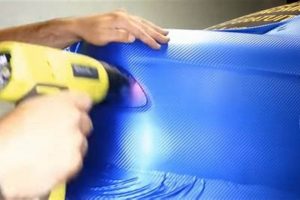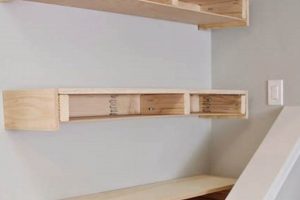A self-constructed apparatus designed to bend sheet metal into precise angles and shapes is commonly built by hobbyists, metalworkers, and small fabrication shops. These units offer a cost-effective alternative to commercially manufactured equipment, allowing for the manipulation of various metal gauges to create custom components or structures. As an example, this device can be employed to fashion brackets, enclosures, or panels from flat metal stock.
The construction of such a tool provides numerous advantages, including reduced initial investment compared to purchasing a factory-made counterpart. It enables greater design flexibility, allowing builders to tailor the specifications of the equipment to their specific needs and project requirements. Historically, the ability to create one’s own forming equipment has been crucial for independent artisans and inventors working with limited resources. This fostered ingenuity and self-reliance within metalworking communities.
The following sections will detail the essential components required for building one of these tools, explore various design approaches, and provide guidance on selecting appropriate materials and construction techniques to ensure accuracy and durability in the finished product.
Construction Recommendations for a DIY Metal Brake
Adhering to specific guidelines during the construction phase is critical for ensuring the accuracy, functionality, and longevity of a self-fabricated metal bending apparatus.
Tip 1: Material Selection: Prioritize high-strength steel for the primary structural components. This ensures the apparatus can withstand the forces exerted during metal forming without deformation.
Tip 2: Accurate Measurement and Cutting: Precise measurements and accurate cuts are essential for the brake’s performance. Employ calibrated measuring tools and utilize cutting methods that minimize material distortion, such as sawing or laser cutting.
Tip 3: Robust Hinge Design: The hinge mechanism connecting the clamping bar and bending leaf must be designed to handle significant stress. Implement reinforced hinges with hardened pivot points to minimize play and maintain consistent bending angles.
Tip 4: Adequate Clamping Force: The clamping system should exert sufficient force to firmly secure the metal sheet during bending. This prevents slippage and ensures clean, precise bends. Consider incorporating adjustable clamping pressure to accommodate various metal thicknesses.
Tip 5: Stiffening the Bending Leaf: To prevent deflection under load, reinforce the bending leaf with ribs or a box-section design. This maintains uniform bending across the entire width of the material.
Tip 6: Implement a Degree Scale: Incorporate a clearly marked degree scale on the bending leaf to facilitate accurate angle settings. This allows for repeatable bends and reduces the risk of error.
Tip 7: Consider Replaceable Wearing Surfaces: Add replaceable wearing surfaces to the clamping bar and bending leaf. This protects the main structure from damage and extends the lifespan of the brake.
Following these guidelines enhances the precision and effectiveness of the fabricated metal brake, leading to improved results and prolonged tool service.
The concluding section will offer insights into operating the equipment safely and provide examples of its potential applications.
1. Material Selection
Material selection is a foundational element in the construction of any self-made sheet metal bending tool. The chosen materials directly dictate the device’s strength, durability, bending capacity, and overall lifespan. Proper material selection balances cost-effectiveness with the performance demands of the intended applications.
- Frame and Structural Components
High-strength steel is the preferred material for the frame and load-bearing components. Steel provides the necessary rigidity to resist deformation during bending operations. For example, using mild steel may result in bending or flexing under load, compromising the accuracy and consistency of the formed metal. Thicker gauge steel members contribute to a more robust and reliable structure.
- Bending Leaf and Clamping Bar
The bending leaf and clamping bar require materials with a high hardness and wear resistance. Tool steel or hardened steel alloys are suitable choices to withstand the abrasive forces encountered during metal forming. The selection of an inadequate material may lead to premature wear, resulting in diminished bending precision and requiring frequent replacements or repairs.
- Hinge Pins and Pivot Points
Hinge pins and pivot points are subjected to considerable stress and friction. Hardened steel or bearing-grade materials are recommended to minimize wear and maintain smooth operation. For instance, using softer metals like brass or aluminum may lead to excessive play and reduced bending accuracy over time.
- Fasteners and Joining Hardware
High-strength bolts, welds, or rivets are critical for securely joining the various components of the metal brake. Grade 8 bolts and robust welding techniques are essential to prevent failure under load. Substandard fasteners may shear or loosen during operation, potentially causing damage to the equipment or injury to the operator.
The careful consideration of material properties, such as yield strength, tensile strength, and hardness, is paramount to building a durable and effective self-made sheet metal bending apparatus. Proper material choices contribute directly to the tool’s performance, accuracy, and operational safety. Conversely, inadequate material selection can lead to premature failure and compromise the integrity of formed metal components.
2. Structural Rigidity
Structural rigidity is a paramount consideration in the design and construction of a self-fabricated sheet metal bending tool. It directly influences the accuracy, consistency, and overall effectiveness of the apparatus. Insufficient rigidity leads to deformation under load, compromising the intended bending angles and potentially damaging the workpiece.
- Frame Stability
The frame constitutes the foundational structure of the metal brake. It must exhibit substantial resistance to bending and twisting forces. A robust frame prevents deflection, ensuring that applied bending forces are translated accurately to the workpiece. Example: Using thick-walled steel tubing or box sections for the frame members significantly enhances stability compared to using thinner sheet metal.
- Clamping Bar Support
The clamping bar securely holds the metal sheet in place during the bending process. Adequate support is essential to prevent the bar from flexing or bowing under c
lamping pressure. Example: Reinforcing the clamping bar with ribs or a backing plate distributes the clamping force evenly across the workpiece, minimizing distortion and ensuring a clean, consistent bend. - Bending Leaf Stiffness
The bending leaf is the active component that applies the bending force to the metal sheet. It must maintain its shape under load to achieve accurate bending angles. Example: Utilizing a box-section design or incorporating stiffening ribs along the length of the bending leaf enhances its resistance to bending and twisting, resulting in more precise and repeatable bends.
- Hinge Integrity
The hinge mechanism connects the clamping bar and bending leaf. Its integrity is crucial for maintaining alignment and preventing play during bending operations. Example: Implementing heavy-duty hinges with hardened pivot points minimizes deflection and ensures that the bending force is applied uniformly, contributing to accurate angle formation.
These elements, acting in concert, define the overall structural rigidity of a self-constructed metal bending tool. The degree of rigidity dictates the tool’s ability to consistently produce accurate bends and withstand the forces encountered during metal forming. A design prioritizing structural integrity ensures a reliable and long-lasting apparatus capable of meeting the demands of various metalworking projects.
3. Hinge Mechanism
The hinge mechanism is a critical component in the functionality of a self-constructed sheet metal bending tool. It serves as the pivotal point around which the bending leaf rotates, enabling the application of force to the metal sheet and facilitating the formation of desired angles. The design and construction of this mechanism directly impact the accuracy, smoothness, and overall effectiveness of the bending process. Failure to properly engineer the hinge can result in inconsistent bends, premature wear, and potential structural failure of the apparatus.
A well-designed hinge mechanism in a fabricated metal brake provides several advantages. It allows for precise control over the bending angle, ensuring consistent results. It distributes stress evenly, minimizing the risk of deformation or breakage. Consider a basic piano hinge versus a custom-fabricated hinge utilizing hardened steel bushings: the latter provides significantly greater load-bearing capacity and smoother operation. Furthermore, a robust hinge design contributes to the longevity of the tool by minimizing wear and tear on moving parts. Proper lubrication and maintenance of the hinge are also essential to ensure continued smooth operation.
In summary, the hinge mechanism is not merely a connecting element; it is a key determinant of the performance and durability of a constructed metal bending tool. Its design, material selection, and construction quality directly affect the accuracy, ease of use, and lifespan of the brake. Therefore, careful attention to the hinge mechanism is essential for anyone undertaking the fabrication of a practical and reliable sheet metal bending solution.
4. Clamping Force
Clamping force, within the context of a self-constructed sheet metal bending tool, is the pressure applied to secure the workpiece during the bending process. It is a critical factor influencing the accuracy, quality, and safety of the formed metal components. Inadequate clamping force leads to slippage, distortion, and inconsistent bends. Conversely, excessive force can damage the material or the bending apparatus itself.
- Preventing Material Slippage
The primary role of clamping force is to prevent the metal sheet from moving during the bending operation. Any slippage results in inaccurate bend angles and dimensions. For example, when bending thicker gauge steel, greater clamping force is required to overcome the increased resistance to deformation. Without sufficient force, the sheet will shift, rendering the bend imprecise and potentially unusable.
- Minimizing Material Distortion
Consistent and even clamping pressure is essential to minimize material distortion near the bend line. Uneven force causes localized stresses that can lead to warping or buckling of the metal. An example of this is using clamping surfaces that are not perfectly parallel, which results in uneven pressure distribution and introduces unwanted deformations in the finished product.
- Impact on Bend Radius
Clamping force indirectly influences the bend radius. Excessive force, combined with a small bend radius, can thin the metal at the bend point or even cause it to fracture. Insufficient clamping allows the metal to “spring back” slightly, resulting in a larger-than-intended radius. Achieving the desired bend radius requires a balance between clamping pressure, material properties, and tool design.
- Safety Considerations
Proper clamping force contributes to operator safety. A securely clamped workpiece minimizes the risk of the material suddenly shifting or ejecting during bending, which can cause serious injury. The clamping mechanism must be designed to withstand the anticipated forces and provide a reliable hold on the metal sheet throughout the bending process.
The ability to effectively control and apply clamping force is a key determinant of the success of any self-constructed sheet metal bending apparatus. A thoughtfully designed clamping system, coupled with careful attention to material selection and bending technique, ensures accurate, consistent, and safe metal forming operations. An insufficient or poorly designed clamping mechanism renders even the most carefully constructed brake ineffective.
5. Angle Accuracy
Attaining precise angles during metal forming is paramount in various fabrication projects. The degree to which a self-constructed sheet metal bending tool can consistently produce accurate angles dictates its usefulness and the quality of the resulting components. Therefore, angle accuracy is a critical performance metric for these devices.
- Calibration and Measurement
Precise calibration of the angle measurement system is essential for achieving accuracy. This includes the use of protractors, angle finders, or digital angle gauges to establish a reliable reference point. For instance, a poorly calibrated degree scale on the bending leaf results in systematic errors, leading to inaccuracies in the final bend angles. Verification against a known standard is crucial for establishing confidence in the angle readings.
- Hinge Precision
The hinge mechanism directly influences the consistency of the bend angle. Play or looseness in the hinge introduces variability, making it difficult to achieve repeatable results. Example: A hinge with excessive clearance allows the bending leaf to deviate slightly from the intended angle, particularly when bending thicker materials that require greater force. Employing tight-tolerance hinges with hardened pivot points is paramount.
- Material Springback
Different metals exhibit varying degrees of springback, which is th
e tendency of the material to return partially to its original shape after bending. Compensating for springback is critical for achieving the desired final angle. An example of this is bending aluminum versus steel; aluminum typically exhibits greater springback, requiring overbending to achieve the target angle after release. Understanding and accounting for material-specific springback characteristics is necessary for accurate bending. - Clamping Consistency
Inconsistent clamping pressure affects the distribution of stress during bending, leading to variations in the final angle. For example, uneven clamping force along the length of the workpiece causes localized bending, resulting in deviations from the intended angle. Maintaining uniform clamping pressure across the entire bending area is crucial for achieving consistent angular accuracy.
These interconnected factors collectively determine the angle accuracy achievable with a self-fabricated metal brake. Neglecting any one of these aspects compromises the overall precision of the tool and reduces its effectiveness in demanding metal forming applications. Attention to detail in design, construction, and calibration is essential for realizing the full potential of a constructed metal bending apparatus.
6. Bending Capacity
Bending capacity, in the context of self-constructed sheet metal bending tools, defines the range of material types, thicknesses, and widths the apparatus can effectively form. It is a critical parameter that dictates the versatility and suitability of the brake for diverse metalworking applications.
- Material Thickness Limitation
A primary determinant of bending capacity is the maximum material thickness the apparatus can handle without exceeding its structural limits. Exceeding this limit risks deformation of the tool or incomplete bends. For example, a brake designed for 16-gauge steel may struggle or fail when attempting to bend 10-gauge steel due to the increased force required. Reinforcing the frame and bending leaf enhances the thickness capacity.
- Material Type Influence
The type of metal significantly affects the bending capacity. Different metals possess varying yield strengths and ductility, influencing the force required for bending and the likelihood of cracking or tearing. Bending aluminum, for example, typically requires less force than bending steel of the same thickness. The brake’s design must account for the specific properties of the intended materials.
- Bending Width Constraint
The width of the metal sheet also impacts the bending capacity. Wider sheets require more force to bend evenly across their length, potentially exceeding the tool’s capabilities. A brake with a narrow bending width may be suitable for small parts but inadequate for forming larger panels. Stiffening the bending leaf minimizes deflection when working with wider materials.
- Design and Leverage
The mechanical design of the brake, including the leverage provided by the bending leaf and the clamping mechanism, plays a crucial role in determining its bending capacity. A well-designed tool maximizes the force applied to the material, allowing it to bend thicker or wider sheets with less effort. Enhancing the leverage ratio increases the bending capacity, but it may also require more robust construction to withstand the increased stresses.
In essence, the bending capacity of a self-fabricated metal brake is a multifaceted characteristic determined by material properties, tool design, and construction quality. Evaluating these factors is essential to ensure the apparatus meets the specific requirements of the intended metalworking projects. Misjudging the bending capacity leads to damage to the tool, substandard results, or unsafe operating conditions.
7. Safety Features
The integration of safety features into a self-constructed sheet metal bending tool is not merely an option but a fundamental necessity. The forces involved in bending metal, coupled with the sharp edges and potential for material ejection, present inherent risks to the operator. A lack of adequate safety measures significantly elevates the probability of injuries, ranging from minor cuts and abrasions to severe lacerations and crushing injuries. Real-world examples illustrate this point: a missing guard on the clamping mechanism can lead to fingers being caught during operation, while the absence of a secure locking mechanism on the bending leaf can result in uncontrolled movement and potential impact injuries.
Effective safety features address potential hazards at various stages of the bending process. One crucial aspect is implementing a secure clamping system that prevents the metal sheet from slipping or ejecting during bending. This involves using clamping mechanisms with adequate force and incorporating non-slip surfaces. Another important element is guarding or shielding moving parts, such as the hinge mechanism and the bending leaf, to prevent accidental contact. Clear and prominent safety warnings, including instructions on proper operation and potential hazards, also contribute to a safer working environment. Furthermore, ensuring adequate lighting and maintaining a clean, uncluttered workspace reduces the risk of slips, trips, and falls.
The development and incorporation of safety features into self-fabricated sheet metal bending equipment pose certain challenges. The builder must possess a thorough understanding of potential hazards and implement solutions that do not compromise the tool’s functionality. Balancing safety with practicality and cost-effectiveness is often a crucial consideration. Despite these challenges, prioritizing safety features is indispensable for ensuring the well-being of the operator and the longevity of the tool, solidifying its place in practical metalworking applications.
Frequently Asked Questions
This section addresses common inquiries regarding the design, construction, and utilization of fabricated sheet metal bending tools.
Question 1: What is the minimum steel thickness recommended for the frame of a fabricated metal brake?
For structural integrity, it is advisable to employ steel with a minimum thickness of 1/4 inch for the frame components. Thinner materials may exhibit unacceptable deflection under load, compromising bending accuracy.
Question 2: How can material springback be effectively compensated for when bending sheet metal?
Compensation for springback involves overbending the material by a specific angle, determined empirically through testing or by consulting material-specific bending charts. The degree of overbending depends on the material type, thickness, and bend radius.
Question 3: What type of hinge mechanism is most suitable for a robust and accurate metal brake?
A hinge employing hardened steel pivot points and tight tolerances is generally preferred. Bushings or bearings minimize friction and prevent play, enhancing bending precision and extending the lifespan of the apparatus.
Question 4: What are the critical considerations when selecting a clamping mechanism for a self-fabricated brake?
The clamping mechanism should exert sufficient and uniform pressure across the workpiece to preven
t slippage during bending. Adjustable clamping pressure is desirable to accommodate varying material thicknesses and prevent damage.
Question 5: How can structural rigidity of the bending leaf be maximized?
The bending leaf should be constructed from thick-walled steel or incorporate a box-section design with internal bracing to resist bending and twisting forces. This ensures accurate and consistent bend angles.
Question 6: What safety precautions should be observed when operating a constructed metal brake?
Eye protection is mandatory. Hands must be kept clear of moving parts during operation. The apparatus should be securely mounted to a stable surface. Ensure the workpiece is properly clamped before initiating bending.
Understanding these key aspects of metal brake design and operation is essential for achieving safe and effective metal forming.
The following section offers concluding thoughts and potential areas for further exploration.
Conclusion
This exploration of the self-constructed sheet metal bending tool underscores the inherent value and challenges associated with its design, fabrication, and operation. From the selection of appropriate materials and the implementation of robust structural elements to the critical consideration of safety features, each facet contributes significantly to the overall performance and utility of the finished apparatus. Angle accuracy, bending capacity, and the efficacy of the clamping mechanism stand as defining attributes, impacting the precision and versatility of the tool. The “diy metal brake” is more than just the sum of its parts; it is a testament to ingenuity and resourcefulness.
The information presented provides a foundation for informed decision-making in the pursuit of custom metal forming solutions. Further investigation into specific bending techniques, material properties, and advanced design methodologies will undoubtedly yield even greater proficiency. The constructed sheet metal bending apparatus, when approached with diligence and a commitment to quality, represents a powerful asset for metalworking endeavors. The future of independent fabrication relies on the ability to adapt, innovate, and construct tools that meet specific needs with efficiency and precision.







